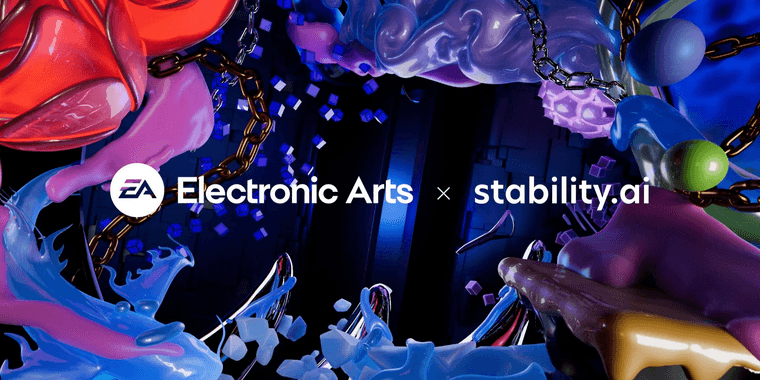Annotation
- Introduction
- Strategic Partnership Details
- Initial Development Focus Areas
- Pros and Cons
- Conclusion
- Frequently Asked Questions
Stability AI & EA Partner for Generative AI Game Development Tools
Stability AI and Electronic Arts partner to integrate generative AI into game development, focusing on PBR materials and 3D environment prototyping to innovate creative workflows.

Introduction
Stability AI and Electronic Arts have formed a groundbreaking partnership to integrate generative artificial intelligence into game development workflows. This collaboration combines Stability AI's technical expertise in generative models with EA's extensive experience in digital entertainment, promising to transform how games are created and prototyped.
Strategic Partnership Details
The partnership develops generative AI models and tools for game creation stages, leveraging Stability AI's AI and EA's expertise to accelerate production.
Initial Development Focus Areas
Initial efforts focus on PBR material creation, with tools for generating accurate 2D textures. It also explores AI for pre-visualizing 3D environments from prompts, aiding level editor and game engine integration in AI image generators and 3D modeling pipelines.
Pros and Cons
Advantages
- Accelerates prototyping and asset creation workflows
- Enables rapid visualization of game concepts
- Reduces manual labor in texture generation
- Supports creative experimentation and iteration
- Potential cost savings in development cycles
- Integration with existing AI APIs and SDKs
- Enhanced collaboration between technical and creative teams
Disadvantages
- Potential job displacement concerns in art departments
- Quality control challenges with AI-generated content
- Dependency on proprietary AI systems and tools
- Learning curve for traditional developers
- Intellectual property considerations for AI outputs
Conclusion
The Stability AI-EA partnership represents a significant step toward AI-driven game development innovation. By combining cutting-edge generative AI with gaming industry expertise, this collaboration could establish new standards for efficiency and creativity in digital entertainment production. As these tools mature, they may change how developers approach asset store creation and animation software integration, benefiting studios and indie creators with AI-powered solutions.
Frequently Asked Questions
What are the main goals of the Stability AI and EA partnership?
The partnership aims to develop generative AI models and tools specifically for game development, focusing on accelerating PBR material creation, texture generation, and 3D environment prototyping to transform creative workflows and reduce production timelines.
How will AI tools benefit game developers and artists?
AI tools will enable faster prototyping, automated asset creation, rapid visualization of game concepts, and reduced manual labor in texture generation, allowing developers to experiment more creatively and iterate quickly during production cycles.
What is Physically Based Rendering (PBR) in game development?
Physically Based Rendering (PBR) is a method for rendering graphics that simulates how light interacts with materials, providing realistic visuals in games by accurately representing surfaces and lighting conditions.
How can AI reduce game development costs?
AI can reduce costs by automating repetitive tasks like texture generation and prototyping, speeding up production cycles, minimizing manual labor, and enabling faster iteration, which lowers overall development time and resources.
What are the ethical concerns of using AI in game art?
Ethical concerns include potential job displacement for artists, quality control issues with AI-generated content, intellectual property rights for AI outputs, and over-reliance on proprietary systems that may limit creative control.
Relevant AI & Tech Trends articles
Stay up-to-date with the latest insights, tools, and innovations shaping the future of AI and technology.
Stoat Chat App: Complete Guide to Revolt Rebranding and Features
Stoat chat app rebranded from Revolt due to legal pressures, maintaining all user data, features, and privacy focus without any required actions from existing users for a seamless transition.
Zorin OS 18: Modern Linux OS with Windows App Support & New Features
Zorin OS 18 is a Linux distribution with a redesigned desktop, enhanced Windows app support, and web apps tool, ideal as a Windows 10 alternative with long-term support until 2029.
AV Linux 25 & MX Moksha 25 Released with Enhanced File Manager & VM Features
AV Linux 25 and MX Moksha 25 are new Linux releases based on Debian Trixie, featuring enhanced file management with Quickemu and YT-DLP integration, tailored for multimedia production and lightweight computing.